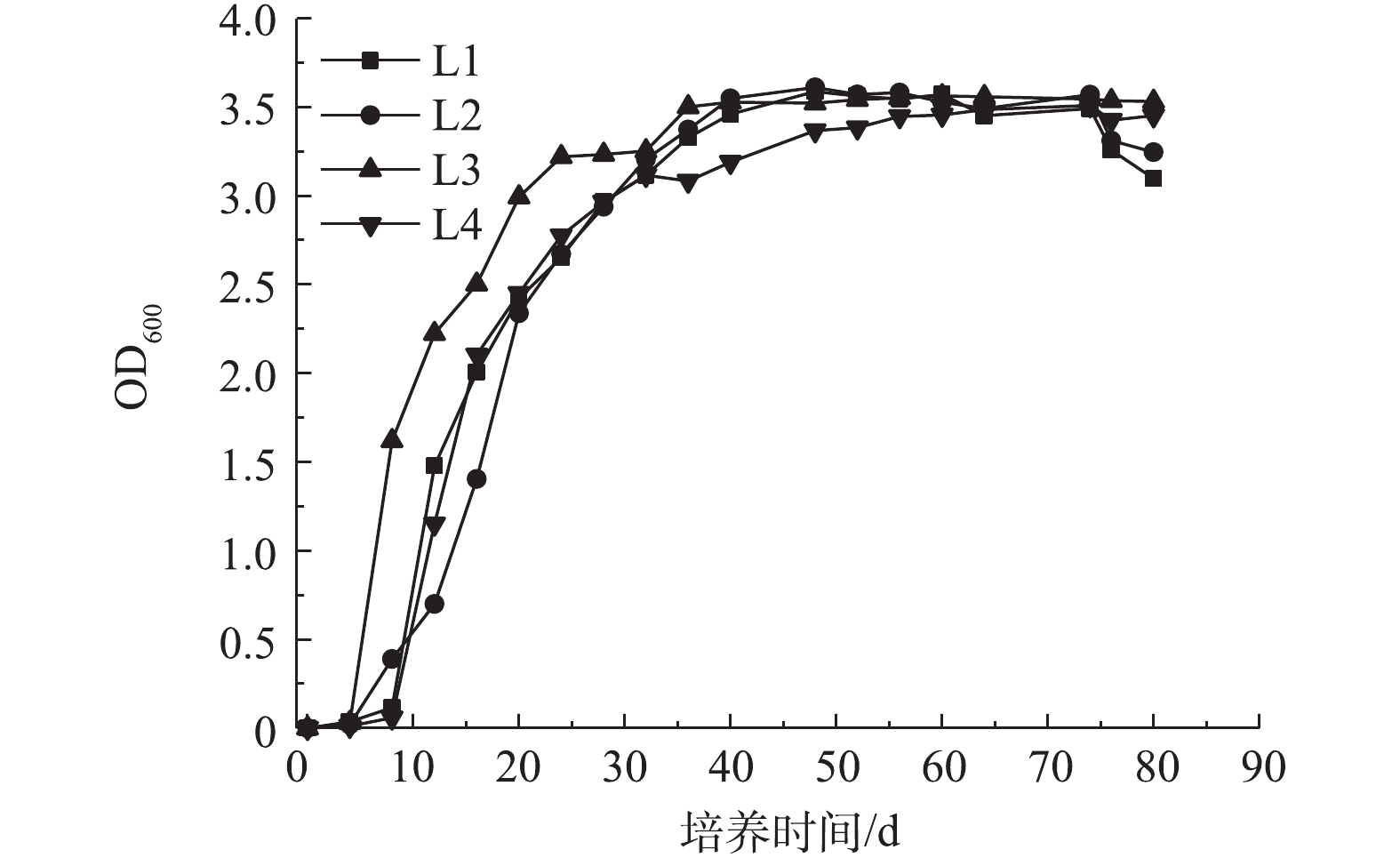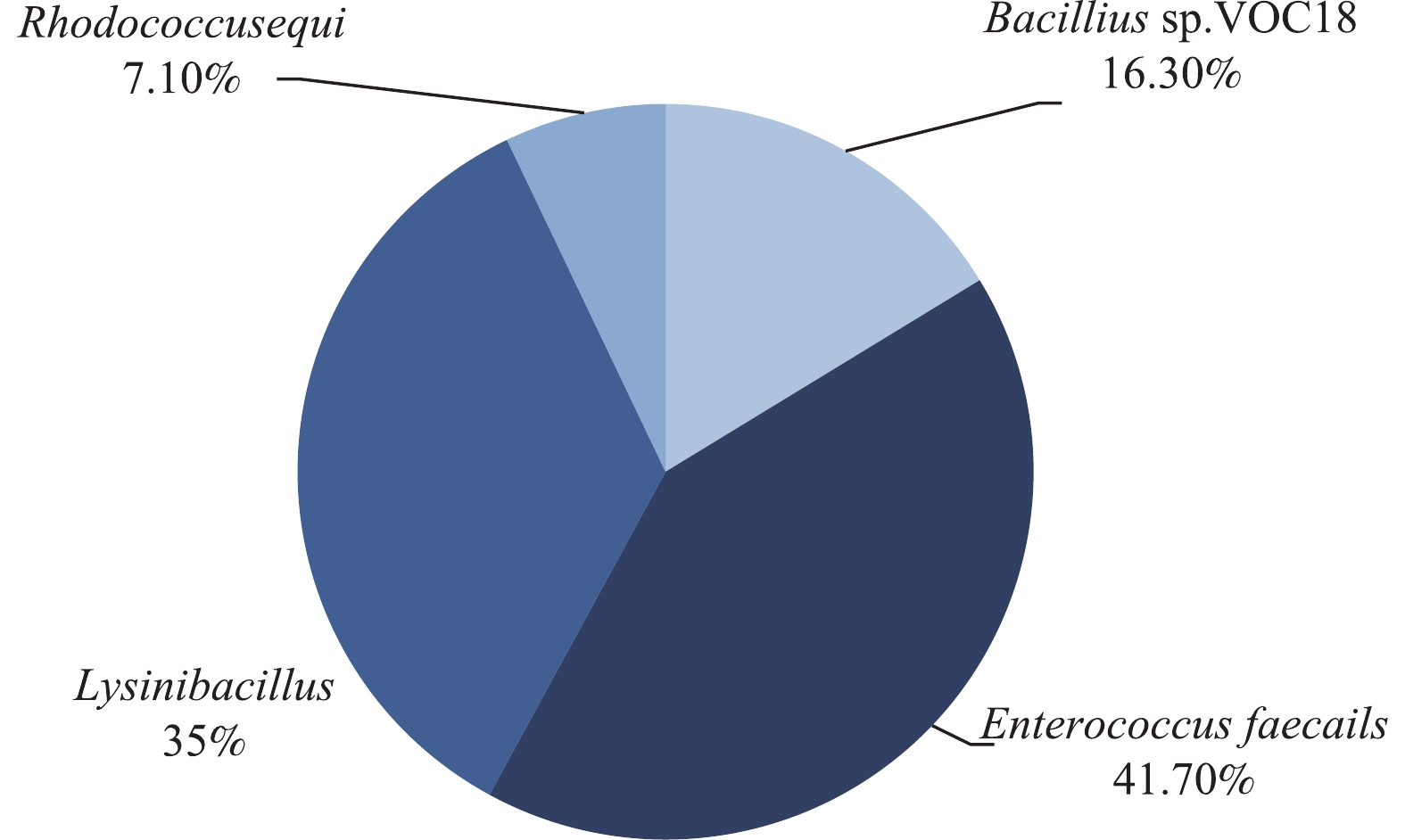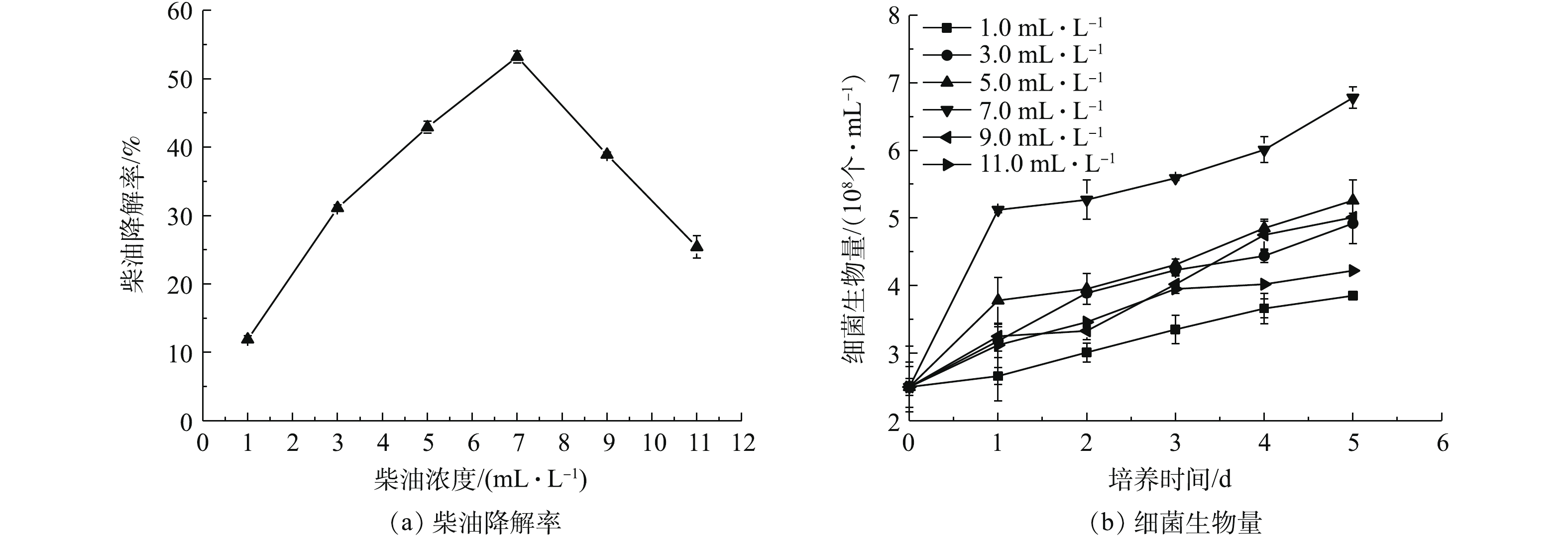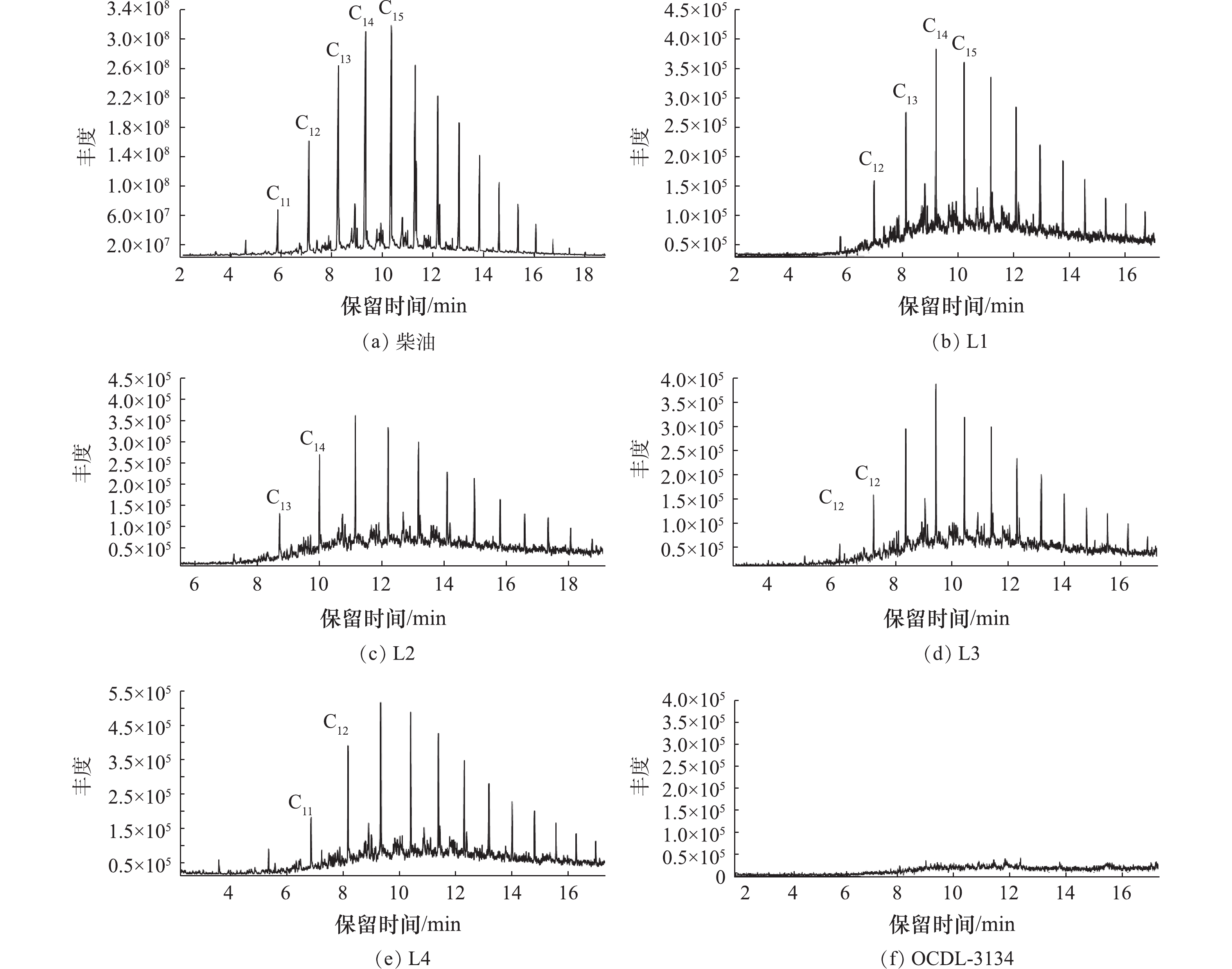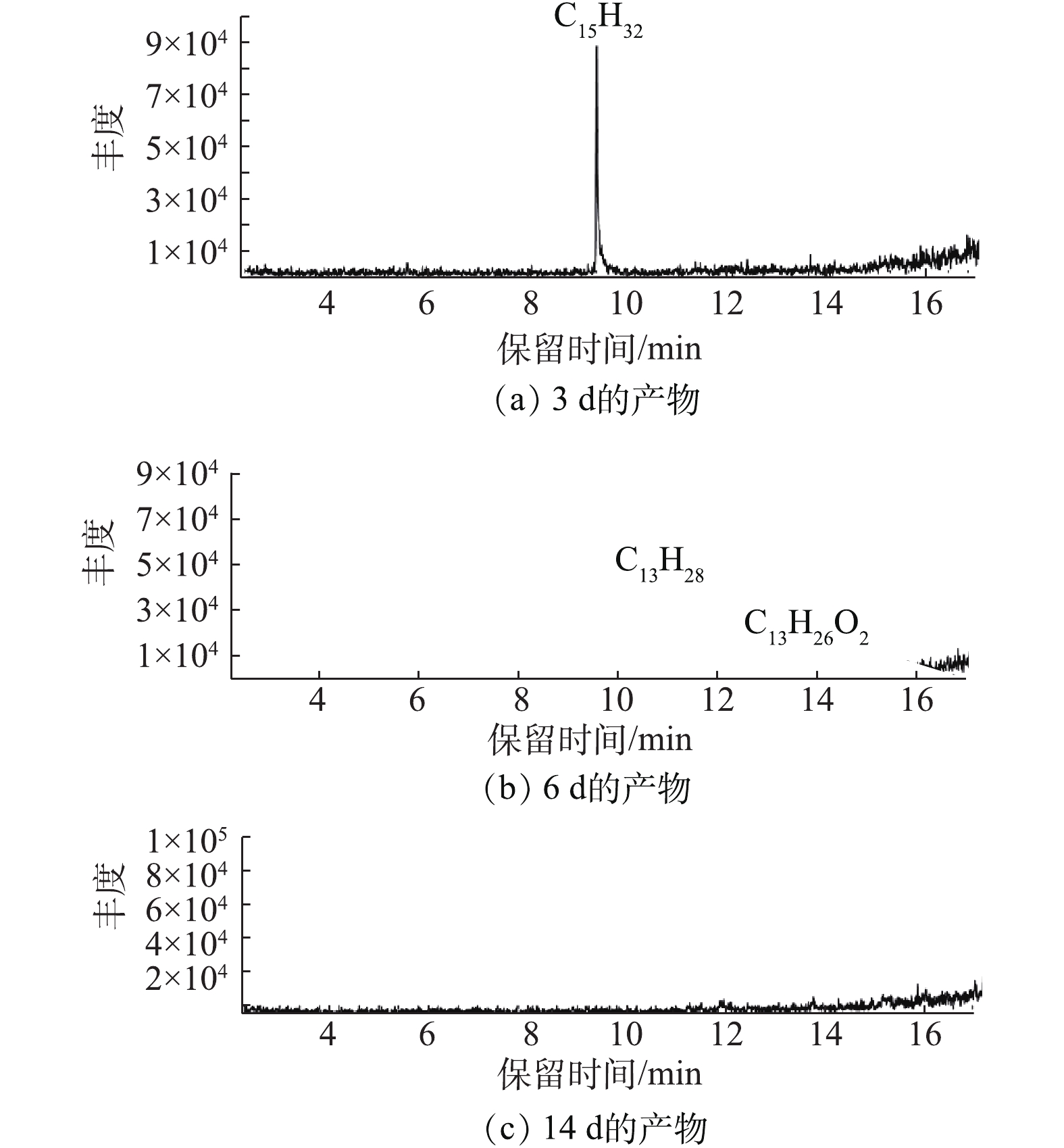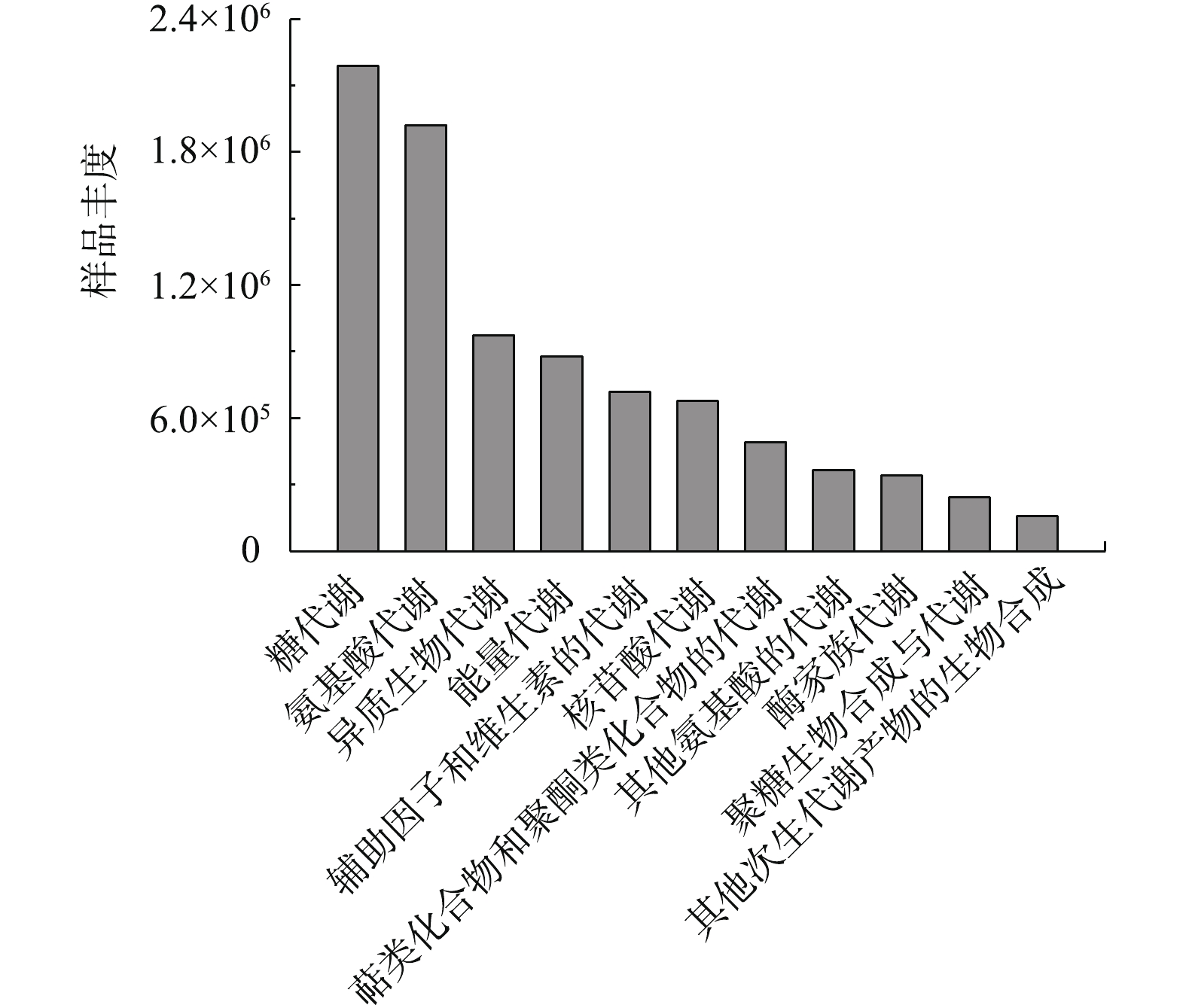-
随着社会经济的发展,柴油的使用量增加,但是柴油在生产、运输、装卸、加工及使用过程中的泄露会对土壤环境造成一定的污染,直接或间接地危害人类的生命与健康[1-2]。因此,解决柴油污染土壤问题已成为世界各国所共同面临的问题[3]。
目前,针对柴油污染土壤修复的方法主要包括机械、物理、化学和生物修复方法等[4]。其中,机械、物理、化学修复方法具有费用高、容易产生二次污染等不足[5-7]。而生物修复技术是一种高效、环境友好、低成本的技术,能够将柴油等污染物通过微生物代谢转化成无毒的终产物[8-9],因而被广泛应用于修复柴油污染土壤之中[10]。刘沙沙等[11]已成功利用醋酸钙不动杆菌降解柴油以及污染物,经过62 d的生物修复实验,柴油去除率为69.8%。然而,柴油组成的复杂性决定了其降解需要有不同菌株的参与[12],TAO等[13]研究了土著细菌联合体与外源芽孢杆菌(Bacillus subtilis)共同培养降解原油的实验,细菌群落分析结果表明,在确定的共培养条件下,细菌多样性降低,降解效率提高,同时证明芽孢杆菌对长链烷烃有很好的降解效果。
大量的研究证明,微生物在修复有机物污染土壤的过程中具有良好的应用前景,但目前对于构建微生物菌群的研究较少,本研究从柴油污染土壤中筛选、分离出能够降解柴油污染物的微生物,采用组合实验构建优势菌群,探究了其柴油生物降解特性,研究分析了该菌群中各菌种之间的互作机制,为构建降解柴油的菌群提供参考。
-
紫外分光光度计(UV-2102C,中国上海),GC-MS(Agilent6890/5975I,安捷伦),台式高速冷冻离心机(H-2050R,中国长沙),恒温振荡培养箱(HZQ-X160,中国太仓)。实验所用试剂均为分析纯。
柴油污染土壤取自上海金山卫金山大道城河路;柴油为市售0#柴油(密度:0.84 kg·L−1);菌种:实验所用菌种均为从柴油污染土壤样品中筛选分离得到。
-
1)微生物菌种生物量的测定方法。将菌落接种于灭菌的种子培养基中,每2 h取样,采用分光光度计在波长600 nm下测定吸光度值,绘制柴油降解细菌的生长曲线。
2)微生物菌种对柴油降解能力的测定方法。残余柴油浓度采用分光光度法[14]进行测定。菌株对柴油的降解能力采用柴油降解率表示。降解率计算公式如式(1)所示。
式中:R为柴油降解率;C0为柴油的初始浓度,mg·mL−1;Ct为柴油的降解过程测定浓度,mg·mL−1。
3)微生物高效降解柴油的条件优化实验。以构建好的柴油污染物降解菌群为研究对象,考察了初始pH(5.0、6.0、7.0、8.0、9.0)、初始柴油浓度(1.0、3.0、5.0、7.0、9.0 mL·L−1)、初始接种量(体积比5.0%、10.0%、15.0%)对柴油降解率和细菌生物量的影响结果。在30 ℃,150 r·min−1条件下培养5 d,定时取样并测定其中的柴油降解率以及生物量的变化,每组实验重复3次,取其平均值。
4)微生物多样性测试。将培养24 h的菌群混合液按10%的接种量接种到无机盐培养基中,柴油浓度为7.0 mL·L−1,pH=7.0,在30 ℃,150 r·min−1条件下培养,14 d后,将混合菌进行收集,离心弃上清液,收集菌体,测试微生物多样性,该工作由上海美吉医药科技有限公司完成。
5)微生物降解柴油产物的检测。将筛选获得的高效单菌种分别接种到种子培养基中,培养24 h后,离心收集菌体,稀释使其OD600=1.50,并按照最佳的体积比混合后接种于无机盐培养基中,以不加细菌为对照组,柴油浓度为7.0 mL·L−1,在30 ℃、150 r·min−1的恒温振荡培养箱中培养14 d。然后将培养基取出加入1∶1(体积比)硫酸5.0 mL酸化水样,继续加入0.2 g·L−1的氯化钠破乳[15],然后加入石油醚20.0 mL(60~90 ℃)超声10 min。将上述溶液8 000 r·min−1离心10 min,将上清液转移至另一干净的三角瓶中,下层溶液倒入原三角瓶并用石油醚重新提取1次。合并2次提取液,过膜,利用GC-MS测定培养基内降解产物组成及含量。
6)微生物降解十五烷产物的检测。将本研究所构建的混合菌群接种于添加了十五烷(7.0 mL·L−1)的无机盐培养基中,在30 ℃、150 r·min−1的振荡箱里培养14 d,分别取降解3、6、14 d的培养液,按照上述方法处理并检测。
-
从柴油污染土壤中筛选获得4株具有较强柴油降解能力的菌株,其菌落形态和柴油降解能力结果见表1。
-
微生物初步鉴定结果如表2所示。通过16S rRNA测序结果可知,1#、2#、3#、4#菌株分别与Bacillus sp. VOC18、Enterococcus faecalis、Lysinibacillus、Rhodococcus equi有97%、98%、99%、99%的相似性。本研究分别对1#、2#、3#、4#菌株命名为Bacillus sp. VOC18-L1,Enterococcus faecalis-L2,Lysinibacillus-L3,Rhodococcus equi-L4(简称L1,L2,L3和L4)。
-
每种菌的生长曲线如图1所示。由图1可知,4种细菌在24 h均进入指数生长阶段,在该阶段,微生物生长速度快,活性较强,因此,后续实验均采用培养24 h的菌液为接种液。
-
菌群构建的结果如表3所示。由表3可知,编号11的菌群组合在5 d内对柴油的降解率最高,可达到39.6%,这可能是由于不同菌种之间的协同作用,使得混合培养的菌群对于柴油污染物的降解效果要优于单菌,因此,选用该混合菌群作为最佳降解菌群进行后续的研究。
-
1)采用正交实验法确定柴油降解菌群的最佳菌种混合比例。菌群中各菌种的相对含量对柴油等有机物的降解效率有显著的影响。因此,本研究通过正交实验研究了不同混合比例的菌种对柴油降解效率的影响关系,结果如表4所示。由表4可知,降解效果最好的菌种比例为L1∶L2∶L3∶L4=3∶1∶3∶4,在5 d时,降解柴油效率为52.5%,本研究将此比例的微生物组合命名为OCDL-3134。由于该菌群中的每种细菌都具有特定的作用,因此,柴油降解效率明显得到提高[16-17]。然而,将培养了14 d的微生物进行多样性分析结果如图2所示,由图2可以看出,OCDL-3134经过14 d的培养后,菌种之间的比例变为2∶6∶5∶1,这说明在降解过程中,4种菌根据环境的变化发挥着协同作用,并自行调整他们之间的相对丰度,以实现充分利用柴油污染物的目的。此时L2和L3菌种变为优势菌种,说明在培养后期,L2和L3菌种发挥了重要作用,这与其自身的功能是相一致的。同时也表明确定各种微生物的初始接种比例的菌群构建方案具有一定的合理性。有研究[18]表明,一旦长链烷烃耗尽,就会缺乏碳源和能量用于其生长,而由长链烷烃降解形成的短链烃类化合物则被其他菌种继续代谢利用而进一步降解。
2)初始pH对OCDL-3134菌体生长和柴油降解效率的影响。环境pH可引起细胞膜电荷的变化,从而影响微生物对营养物质的吸收,影响代谢过程中酶的活性,改变营养物质的可给性和有害物质的毒性。本研究探讨了初始pH对OCDL-3134菌体生长和柴油降解效率的影响。由图3(a)可知,当环境pH过高或过低时,会对微生物产生抑制,这可能是由于此条件严重影响了细菌利用柴油的能量和物质代谢进程,从而影响菌体生长,因此会显著降低柴油的生物降解效率。当pH为7.0时,OCDL-3134对柴油降解的效率达到最佳,此时生物量也达到最高,如图3(b)所示。因此,OCDL-3134对柴油的降解效率和生物量的最佳初始pH均为7.0。
3)柴油浓度对OCDL-3134菌体生长和柴油降解效率的影响。柴油浓度是微生物代谢过程的一个重要因素,对微生物降解性能有一定影响[19]。柴油浓度较低时,碳源不足,细菌生长缓慢,对柴油降解效果不佳。随着柴油浓度的增加,碳源可以满足微生物生长,微生物的降解效果也随之增大。但随着柴油浓度继续增加,柴油降解菌的活性受到抑制,同时培养基表面形成一层油膜,使得溶液内的溶解氧浓度降低,抑制微生物的生长繁殖,从而影响对柴油的降解。如图4(a)所示,随着柴油浓度的增大,微生物的柴油降解率呈先上升后下降的趋势,在柴油浓度为7.0 mL·L−1时,降解效果最好,达到50.0%以上。同时,图4(b)为初始柴油浓度对生物量的影响结果,随着柴油初始浓度的增加,生物量呈先增后降的趋势,结果表明OCDL-3134在初始柴油浓度为7.0 mL·L−1时生物量最佳。
4)接种量对OCDL-3134菌体生长和柴油降解效率的影响。如图5所示,接种量在体积比为10.0%时,微生物对柴油的降解率较高。此后,再增加接种量反而导致新增细胞减少,进而使菌株整体活性下降,降解柴油的后劲不足。15.0%的接种量虽然生物量最多,但由于微生物大量繁殖,造成菌株集中,短时间内消耗了培养基中大量营养成分,不利于新菌株的持续生长,从而影响了菌株对柴油的降解率,因此,根据实验结果最佳接种量为10.0%。
-
1)菌群OCDL-3134降解柴油过程中的产物分析。各单菌种和OCDL-3134对柴油降解的产物结果如图6所示。图6(a)是原始柴油的组分,由此可知,原始柴油的组分非常复杂,主要包括C13~C24的烷烃。图6(b)是L1培养14 d后的产物,通过与图6(a)对比可发现,L1对短链烷烃降解效果好,推测可能是由于该菌在生长代谢过程中产生了相应的表面活性剂[13],促进了微生物与柴油的接触,从而对短链烷烃具有较好的降解效果;图6(c)是L2培养14 d后的产物,通过与图6(a)对比可发现,整体烃类的含量降低。该菌株具有利用该有机物代谢产酸的能力[20],可以将柴油降解的一些产物分解成小分子的酸,因此,在柴油降解过程中发挥着重要作用;图6(d)是L3培养14 d后的产物。与图6(a)对比可发现,短链以及长链烷烃的含量菌有所减少。该菌能够在好氧条件下代谢简单的碳水化合物,因此,在小分子烃类物质的降解过程具有重要作用,同时在柴油降解的后期可能会具有重要贡献,这一点与图3的结果是一致的;图6(e)是L4培养14 d后产物,与图6(a)对比可发现,整体的烃类含量降低,而环苜蓿烯的含量也有明显的下降。有研究[20]表明,该菌株的主要特性是能够有效降解芳香烃,因此,对于柴油中芳香烃的降解具有重要作用。
综上所述,L1、L2、L3、L4对柴油污染物中的有机烃类物质具有一定的降解效果,并且不同的菌种对不同链长的烃类物质降解效果也有显著差异。然而,L1、L2、L3、L4却不能将柴油完全降解。而L1、L2、L3、L4混合形成的菌群OCDL-3134对柴油降解效果显著,如图6(f)所示,相同时间内,柴油几乎被完全降解,转化成无毒无害的酸类小分子、二氧化碳和水。这表明混合菌对柴油的降解效率显著优于单菌株。
2)菌群OCDL-3134降解十五烷过程中的产物分析。使用GC-MS检测了以柴油作为碳源的微生物降解的产物,实验结果表明,混合菌群对柴油的降解效果显著优于单菌种的效果。对此已有大量研究[21]证明了微生物对柴油等有机污染物的降解作用,但是生物降解长链烷烃的机理研究报道并不多见,而且对其降解途径也缺乏了解。由于柴油属于混合物,且主要的烷烃为十五烷和十六烷,因此,本研究选择十五烷作为研究对象,初步探讨微生物降解十五烷的机理,如图7所示。由图7(a)可知,第3天样品中的主要成分是十五烷,这表明在前3 d菌种要先适应新环境,降解效率低。而到第6天,OCDL-3134中的各菌种在协同作用下将十五烷降解为C13H28、C13H26O2等化合物,如图7(b)所示。据报道[15],微生物对直链烷烃最常见的降解途径为烷烃末端氧化,微生物攻击直链烷烃的末端甲基,由加氧酶、脱氢酶、水化酶等混合功能氧化酶催化,生成伯醇,再进一步氧化为醛和脂肪酸,脂肪酸接着通过氧化进一步代谢,被彻底氧化成二氧化碳和水。如图7(c)所示,在第15天,十五烷以及产物被OCDL-3134彻底降解为水和二氧化碳等小分子物质。
3) OCDL-3134降解柴油过程中细菌代谢功能的预测。图8是从KEGG数据库中获得的代谢丰度图,碳水化合物代谢的丰度最好,表明微生物一开始是对柴油的代谢,而氨基酸的代谢功能丰度是其次的,可能发挥的作用是对中间代谢产物脱氨基,从而进一步代谢成醛、酮、酸等小分子物质,因此,细菌首先利用柴油,并将柴油分解成中间代谢产物,然后经过代谢途径分解成酸类小分子物质。其他的代谢途径如能量代谢、辅因子和维生素的代谢、核酸代谢等也参与进来,最终一起合作完成降解柴油的任务。而且可以发现,4种菌种的异质降解和代谢丰度较好,这一代谢丰度说明微生物具有增强降解柴油的能力,这与TAO等[13]的研究结果相一致,但由于是混合菌,故不能判断是哪一种菌种产生的作用。代谢功能预测进一步证明了混合菌在柴油完全降解方面优于单种菌种。
-
1)通过排列组合的方式将筛选出的微生物菌种进行组合,得出高效柴油降解菌群OCDL-3134,通过正交实验得出它们之间接种量最优比例为3∶1∶3∶4,同时对混合菌柴油降解性能进行优化,实验测得微生物降解柴油的最优条件为pH=7.0,初始柴油的浓度为7.0 mL·L−1,初始接种量为10.0%,在此优化条件下,测得第14天柴油的最佳降解率为89.0%,这说明所筛选的混合菌种具有较高的应用价值。
2)通过GC-MS检测和微生物多样性功能预测分析证明了微生物对柴油以及十五烷的协同作用高于单菌株的降解效果,4种菌种之间存在协同作用,能够将长链烷烃降解为短链烷烃和小分子物质,并获得自身生长与代谢的能源和碳源。KEGG数据库中获得的代谢丰度图也进一步证明了混合菌在柴油完全降解方面优单种菌种。
柴油降解菌的筛选、菌群构建及其对柴油和十五烷的降解机理
Screening and community construction of diesel oil degrading bacteria and their degradation mechanism of diesel oil and pentadecane
-
摘要: 针对柴油污染土壤生物修复技术效率低的问题,通过构建高效降解菌群修复柴油污染的土壤,采用组合优化和正交实验构建最佳组合与接种比例的菌群,并研究其柴油降解特性。结果表明,通过筛选、鉴定并命名的4株柴油降解菌为Bacillus sp. VOC18-L1、Enterococcus faecalis-L2、Lysinibacillus-L3、Rhodococcus equi-L4;当4株菌接种比例为3∶1∶3∶4,pH = 7.0,30 ℃,转速150 r·min−1时,柴油降解的效果最佳,14 d对7.0 mL·L−1的柴油降解率达到89.0%。通过气相色谱质谱联用仪(GC-MS)检测柴油降解产物,发现该混合菌株能将柴油中的烷烃降解为短链烷烃,最终转化为小分子物质。同时利用KEGG数据库获得代谢丰度图并初步预测每种菌的功能,根据微生物多样性测试结果,进一步证明了混合菌对柴油完全降解的效果优于单种菌种。通过人工构建的微生物菌群可以有效地应用于柴油污染土壤的修复。Abstract: In view of the current low efficiency of bioremediation technology for diesel oil-contaminated soil, a highly efficient flora was constructed to remediate the polluted soil. A combinatorial optimization and orthogonal design were used to construct the flora with the optimal combination and inoculation ratios, and their degradation characteristics of the diesel oil were also studied. The results showed that four diesel degrading bacteria were screened, identified and named as Bacillus sp. VOC18-L1、Enterococcus faecalis-L2、Lysinibacillus-L3、Rhodococcus equi-L4. The optimal degradation efficiency was obtained at their inoculation ratios of 3∶1∶3∶4, pH=7.0, 30 ℃ and the rotational speed of 150 r·min−1. After 14 days of incubation, the degradation efficiency of 7.0 mL·L−1 diesel oil reached 89.0%. The degradation products of diesel oil were detected using GC-MS, which indicated that these mixed strains could first degrade the long-chain alkanes in diesel oil into short-chain alkanes and finally converted them into some small molecular organics. The metabolic abundance maps obtained from KEGG database were used to predict the functions of each strain. According to the results of microbial diversity test, it was further proven that the mixed flora was superior to pure strain in the complete degradation of diesel oil. The artificially optimized and constructed microbial flora could effectively degrade diesel oil in contaminated soil.
-
随着社会经济的发展,柴油的使用量增加,但是柴油在生产、运输、装卸、加工及使用过程中的泄露会对土壤环境造成一定的污染,直接或间接地危害人类的生命与健康[1-2]。因此,解决柴油污染土壤问题已成为世界各国所共同面临的问题[3]。
目前,针对柴油污染土壤修复的方法主要包括机械、物理、化学和生物修复方法等[4]。其中,机械、物理、化学修复方法具有费用高、容易产生二次污染等不足[5-7]。而生物修复技术是一种高效、环境友好、低成本的技术,能够将柴油等污染物通过微生物代谢转化成无毒的终产物[8-9],因而被广泛应用于修复柴油污染土壤之中[10]。刘沙沙等[11]已成功利用醋酸钙不动杆菌降解柴油以及污染物,经过62 d的生物修复实验,柴油去除率为69.8%。然而,柴油组成的复杂性决定了其降解需要有不同菌株的参与[12],TAO等[13]研究了土著细菌联合体与外源芽孢杆菌(Bacillus subtilis)共同培养降解原油的实验,细菌群落分析结果表明,在确定的共培养条件下,细菌多样性降低,降解效率提高,同时证明芽孢杆菌对长链烷烃有很好的降解效果。
大量的研究证明,微生物在修复有机物污染土壤的过程中具有良好的应用前景,但目前对于构建微生物菌群的研究较少,本研究从柴油污染土壤中筛选、分离出能够降解柴油污染物的微生物,采用组合实验构建优势菌群,探究了其柴油生物降解特性,研究分析了该菌群中各菌种之间的互作机制,为构建降解柴油的菌群提供参考。
1. 材料与方法
1.1 实验仪器与原料
紫外分光光度计(UV-2102C,中国上海),GC-MS(Agilent6890/5975I,安捷伦),台式高速冷冻离心机(H-2050R,中国长沙),恒温振荡培养箱(HZQ-X160,中国太仓)。实验所用试剂均为分析纯。
柴油污染土壤取自上海金山卫金山大道城河路;柴油为市售0#柴油(密度:0.84 kg·L−1);菌种:实验所用菌种均为从柴油污染土壤样品中筛选分离得到。
1.2 实验方法
1)微生物菌种生物量的测定方法。将菌落接种于灭菌的种子培养基中,每2 h取样,采用分光光度计在波长600 nm下测定吸光度值,绘制柴油降解细菌的生长曲线。
2)微生物菌种对柴油降解能力的测定方法。残余柴油浓度采用分光光度法[14]进行测定。菌株对柴油的降解能力采用柴油降解率表示。降解率计算公式如式(1)所示。
R=C0−CtC0×100% (1) 式中:R为柴油降解率;C0为柴油的初始浓度,mg·mL−1;Ct为柴油的降解过程测定浓度,mg·mL−1。
3)微生物高效降解柴油的条件优化实验。以构建好的柴油污染物降解菌群为研究对象,考察了初始pH(5.0、6.0、7.0、8.0、9.0)、初始柴油浓度(1.0、3.0、5.0、7.0、9.0 mL·L−1)、初始接种量(体积比5.0%、10.0%、15.0%)对柴油降解率和细菌生物量的影响结果。在30 ℃,150 r·min−1条件下培养5 d,定时取样并测定其中的柴油降解率以及生物量的变化,每组实验重复3次,取其平均值。
4)微生物多样性测试。将培养24 h的菌群混合液按10%的接种量接种到无机盐培养基中,柴油浓度为7.0 mL·L−1,pH=7.0,在30 ℃,150 r·min−1条件下培养,14 d后,将混合菌进行收集,离心弃上清液,收集菌体,测试微生物多样性,该工作由上海美吉医药科技有限公司完成。
5)微生物降解柴油产物的检测。将筛选获得的高效单菌种分别接种到种子培养基中,培养24 h后,离心收集菌体,稀释使其OD600=1.50,并按照最佳的体积比混合后接种于无机盐培养基中,以不加细菌为对照组,柴油浓度为7.0 mL·L−1,在30 ℃、150 r·min−1的恒温振荡培养箱中培养14 d。然后将培养基取出加入1∶1(体积比)硫酸5.0 mL酸化水样,继续加入0.2 g·L−1的氯化钠破乳[15],然后加入石油醚20.0 mL(60~90 ℃)超声10 min。将上述溶液8 000 r·min−1离心10 min,将上清液转移至另一干净的三角瓶中,下层溶液倒入原三角瓶并用石油醚重新提取1次。合并2次提取液,过膜,利用GC-MS测定培养基内降解产物组成及含量。
6)微生物降解十五烷产物的检测。将本研究所构建的混合菌群接种于添加了十五烷(7.0 mL·L−1)的无机盐培养基中,在30 ℃、150 r·min−1的振荡箱里培养14 d,分别取降解3、6、14 d的培养液,按照上述方法处理并检测。
2. 结果与讨论
2.1 柴油降解菌的富集驯化结果
从柴油污染土壤中筛选获得4株具有较强柴油降解能力的菌株,其菌落形态和柴油降解能力结果见表1。
表 1 菌株的菌落形状及柴油降解能力Table 1. Colony shape and diesel degradability of strains菌株号 菌落形态 菌体形态 菌落颜色 降解率/% 1# 菌落为扁平、边缘不整齐、表面粗糙皱褶 杆状 白色 27.0 2# 菌落透明、光滑、有光泽 球形 白色 29.0 3# 菌落微黄、表面光滑、边缘整齐 杆状 微黄色 32.0 4# 菌落淡红色、湿润、不规则 杆状 淡红色 35.0 2.2 高效降解菌的初步鉴定
微生物初步鉴定结果如表2所示。通过16S rRNA测序结果可知,1#、2#、3#、4#菌株分别与Bacillus sp. VOC18、Enterococcus faecalis、Lysinibacillus、Rhodococcus equi有97%、98%、99%、99%的相似性。本研究分别对1#、2#、3#、4#菌株命名为Bacillus sp. VOC18-L1,Enterococcus faecalis-L2,Lysinibacillus-L3,Rhodococcus equi-L4(简称L1,L2,L3和L4)。
表 2 4种柴油降解菌株的生理生化实验结果Table 2. Physiological and biochemical characteristics of four diesel degrading bacteria实验类型 菌株号 1# 2# 3# 4# 淀粉水解实验 − − − − 明胶实验 + − + + 尿素实验 − + − − 甲基红实验 + − + + V-P实验 + − + − 吲哚实验 − − − − 柠檬酸盐实验 − − − − 硫化氢实验 − − − + 触酶实验 − + − + 葡萄糖发酵实验 + − + + 乳糖发酵实验 − − − − 木糖发酵实验 − − − − 麦芽糖发酵实验 + − + + 蔗糖发酵实验 + − − − 注:“+”表示显阳性,“−”表示显阴性。 2.3 菌株的生长曲线分析结果
每种菌的生长曲线如图1所示。由图1可知,4种细菌在24 h均进入指数生长阶段,在该阶段,微生物生长速度快,活性较强,因此,后续实验均采用培养24 h的菌液为接种液。
2.4 菌群构建的结果分析
菌群构建的结果如表3所示。由表3可知,编号11的菌群组合在5 d内对柴油的降解率最高,可达到39.6%,这可能是由于不同菌种之间的协同作用,使得混合培养的菌群对于柴油污染物的降解效果要优于单菌,因此,选用该混合菌群作为最佳降解菌群进行后续的研究。
表 3 菌种组合对柴油降解效率的实验结果Table 3. Experimental results of degradation efficiency of diesel oil by species strain combination编号 组合 降解率/% 1 L1+L2 20.9 2 L1+L3 26.2 3 L1+L4 26.1 4 L2+L3 25.8 5 L2+L4 30.9 6 L3+L4 29.3 7 L1+L2+L3 23.5 8 L1+L2+L4 31.5 9 L1+L3+L4 25.0 10 L2+L3+L4 21.1 11 L1+L2+L3+L4 39.6 12 空白 10.9 2.5 柴油降解菌群的混合配比及降解柴油的条件优化
1)采用正交实验法确定柴油降解菌群的最佳菌种混合比例。菌群中各菌种的相对含量对柴油等有机物的降解效率有显著的影响。因此,本研究通过正交实验研究了不同混合比例的菌种对柴油降解效率的影响关系,结果如表4所示。由表4可知,降解效果最好的菌种比例为L1∶L2∶L3∶L4=3∶1∶3∶4,在5 d时,降解柴油效率为52.5%,本研究将此比例的微生物组合命名为OCDL-3134。由于该菌群中的每种细菌都具有特定的作用,因此,柴油降解效率明显得到提高[16-17]。然而,将培养了14 d的微生物进行多样性分析结果如图2所示,由图2可以看出,OCDL-3134经过14 d的培养后,菌种之间的比例变为2∶6∶5∶1,这说明在降解过程中,4种菌根据环境的变化发挥着协同作用,并自行调整他们之间的相对丰度,以实现充分利用柴油污染物的目的。此时L2和L3菌种变为优势菌种,说明在培养后期,L2和L3菌种发挥了重要作用,这与其自身的功能是相一致的。同时也表明确定各种微生物的初始接种比例的菌群构建方案具有一定的合理性。有研究[18]表明,一旦长链烷烃耗尽,就会缺乏碳源和能量用于其生长,而由长链烷烃降解形成的短链烃类化合物则被其他菌种继续代谢利用而进一步降解。
表 4 4种柴油降解菌的接种比例和对应的柴油降解效率表Table 4. Inoculation ratio of four diesel oil degrading bacteria and their diesel oil biodegradation efficiency接种比例(L1∶L2∶L3∶L4) 降解率/% 接种比例(L1∶L2∶L3∶L4) 降解率/% 3∶3∶1∶2 16.5 2∶4∶3∶2 14.8 1∶1∶1∶1 39.3 4∶1∶4∶2 18.5 2∶1∶2∶3 15.3 2∶2∶1∶4 15.7 4∶4∶1∶3 21.4 4∶3∶2∶4 19.1 3∶4∶2∶1 15.6 1∶2∶2∶2 25.5 2∶3∶4∶1 13.7 3∶1∶3∶4 52.5 1∶4∶4∶4 22.3 3∶2∶4∶3 13.2 1∶3∶3∶3 13.1 4∶2∶3∶1 11.7 2)初始pH对OCDL-3134菌体生长和柴油降解效率的影响。环境pH可引起细胞膜电荷的变化,从而影响微生物对营养物质的吸收,影响代谢过程中酶的活性,改变营养物质的可给性和有害物质的毒性。本研究探讨了初始pH对OCDL-3134菌体生长和柴油降解效率的影响。由图3(a)可知,当环境pH过高或过低时,会对微生物产生抑制,这可能是由于此条件严重影响了细菌利用柴油的能量和物质代谢进程,从而影响菌体生长,因此会显著降低柴油的生物降解效率。当pH为7.0时,OCDL-3134对柴油降解的效率达到最佳,此时生物量也达到最高,如图3(b)所示。因此,OCDL-3134对柴油的降解效率和生物量的最佳初始pH均为7.0。
3)柴油浓度对OCDL-3134菌体生长和柴油降解效率的影响。柴油浓度是微生物代谢过程的一个重要因素,对微生物降解性能有一定影响[19]。柴油浓度较低时,碳源不足,细菌生长缓慢,对柴油降解效果不佳。随着柴油浓度的增加,碳源可以满足微生物生长,微生物的降解效果也随之增大。但随着柴油浓度继续增加,柴油降解菌的活性受到抑制,同时培养基表面形成一层油膜,使得溶液内的溶解氧浓度降低,抑制微生物的生长繁殖,从而影响对柴油的降解。如图4(a)所示,随着柴油浓度的增大,微生物的柴油降解率呈先上升后下降的趋势,在柴油浓度为7.0 mL·L−1时,降解效果最好,达到50.0%以上。同时,图4(b)为初始柴油浓度对生物量的影响结果,随着柴油初始浓度的增加,生物量呈先增后降的趋势,结果表明OCDL-3134在初始柴油浓度为7.0 mL·L−1时生物量最佳。
4)接种量对OCDL-3134菌体生长和柴油降解效率的影响。如图5所示,接种量在体积比为10.0%时,微生物对柴油的降解率较高。此后,再增加接种量反而导致新增细胞减少,进而使菌株整体活性下降,降解柴油的后劲不足。15.0%的接种量虽然生物量最多,但由于微生物大量繁殖,造成菌株集中,短时间内消耗了培养基中大量营养成分,不利于新菌株的持续生长,从而影响了菌株对柴油的降解率,因此,根据实验结果最佳接种量为10.0%。
2.6 菌群OCDL-3134降解柴油及十五烷过程中的产物分析
1)菌群OCDL-3134降解柴油过程中的产物分析。各单菌种和OCDL-3134对柴油降解的产物结果如图6所示。图6(a)是原始柴油的组分,由此可知,原始柴油的组分非常复杂,主要包括C13~C24的烷烃。图6(b)是L1培养14 d后的产物,通过与图6(a)对比可发现,L1对短链烷烃降解效果好,推测可能是由于该菌在生长代谢过程中产生了相应的表面活性剂[13],促进了微生物与柴油的接触,从而对短链烷烃具有较好的降解效果;图6(c)是L2培养14 d后的产物,通过与图6(a)对比可发现,整体烃类的含量降低。该菌株具有利用该有机物代谢产酸的能力[20],可以将柴油降解的一些产物分解成小分子的酸,因此,在柴油降解过程中发挥着重要作用;图6(d)是L3培养14 d后的产物。与图6(a)对比可发现,短链以及长链烷烃的含量菌有所减少。该菌能够在好氧条件下代谢简单的碳水化合物,因此,在小分子烃类物质的降解过程具有重要作用,同时在柴油降解的后期可能会具有重要贡献,这一点与图3的结果是一致的;图6(e)是L4培养14 d后产物,与图6(a)对比可发现,整体的烃类含量降低,而环苜蓿烯的含量也有明显的下降。有研究[20]表明,该菌株的主要特性是能够有效降解芳香烃,因此,对于柴油中芳香烃的降解具有重要作用。
综上所述,L1、L2、L3、L4对柴油污染物中的有机烃类物质具有一定的降解效果,并且不同的菌种对不同链长的烃类物质降解效果也有显著差异。然而,L1、L2、L3、L4却不能将柴油完全降解。而L1、L2、L3、L4混合形成的菌群OCDL-3134对柴油降解效果显著,如图6(f)所示,相同时间内,柴油几乎被完全降解,转化成无毒无害的酸类小分子、二氧化碳和水。这表明混合菌对柴油的降解效率显著优于单菌株。
2)菌群OCDL-3134降解十五烷过程中的产物分析。使用GC-MS检测了以柴油作为碳源的微生物降解的产物,实验结果表明,混合菌群对柴油的降解效果显著优于单菌种的效果。对此已有大量研究[21]证明了微生物对柴油等有机污染物的降解作用,但是生物降解长链烷烃的机理研究报道并不多见,而且对其降解途径也缺乏了解。由于柴油属于混合物,且主要的烷烃为十五烷和十六烷,因此,本研究选择十五烷作为研究对象,初步探讨微生物降解十五烷的机理,如图7所示。由图7(a)可知,第3天样品中的主要成分是十五烷,这表明在前3 d菌种要先适应新环境,降解效率低。而到第6天,OCDL-3134中的各菌种在协同作用下将十五烷降解为C13H28、C13H26O2等化合物,如图7(b)所示。据报道[15],微生物对直链烷烃最常见的降解途径为烷烃末端氧化,微生物攻击直链烷烃的末端甲基,由加氧酶、脱氢酶、水化酶等混合功能氧化酶催化,生成伯醇,再进一步氧化为醛和脂肪酸,脂肪酸接着通过氧化进一步代谢,被彻底氧化成二氧化碳和水。如图7(c)所示,在第15天,十五烷以及产物被OCDL-3134彻底降解为水和二氧化碳等小分子物质。
3) OCDL-3134降解柴油过程中细菌代谢功能的预测。图8是从KEGG数据库中获得的代谢丰度图,碳水化合物代谢的丰度最好,表明微生物一开始是对柴油的代谢,而氨基酸的代谢功能丰度是其次的,可能发挥的作用是对中间代谢产物脱氨基,从而进一步代谢成醛、酮、酸等小分子物质,因此,细菌首先利用柴油,并将柴油分解成中间代谢产物,然后经过代谢途径分解成酸类小分子物质。其他的代谢途径如能量代谢、辅因子和维生素的代谢、核酸代谢等也参与进来,最终一起合作完成降解柴油的任务。而且可以发现,4种菌种的异质降解和代谢丰度较好,这一代谢丰度说明微生物具有增强降解柴油的能力,这与TAO等[13]的研究结果相一致,但由于是混合菌,故不能判断是哪一种菌种产生的作用。代谢功能预测进一步证明了混合菌在柴油完全降解方面优于单种菌种。
3. 结论
1)通过排列组合的方式将筛选出的微生物菌种进行组合,得出高效柴油降解菌群OCDL-3134,通过正交实验得出它们之间接种量最优比例为3∶1∶3∶4,同时对混合菌柴油降解性能进行优化,实验测得微生物降解柴油的最优条件为pH=7.0,初始柴油的浓度为7.0 mL·L−1,初始接种量为10.0%,在此优化条件下,测得第14天柴油的最佳降解率为89.0%,这说明所筛选的混合菌种具有较高的应用价值。
2)通过GC-MS检测和微生物多样性功能预测分析证明了微生物对柴油以及十五烷的协同作用高于单菌株的降解效果,4种菌种之间存在协同作用,能够将长链烷烃降解为短链烷烃和小分子物质,并获得自身生长与代谢的能源和碳源。KEGG数据库中获得的代谢丰度图也进一步证明了混合菌在柴油完全降解方面优单种菌种。
-
表 1 菌株的菌落形状及柴油降解能力
Table 1. Colony shape and diesel degradability of strains
菌株号 菌落形态 菌体形态 菌落颜色 降解率/% 1# 菌落为扁平、边缘不整齐、表面粗糙皱褶 杆状 白色 27.0 2# 菌落透明、光滑、有光泽 球形 白色 29.0 3# 菌落微黄、表面光滑、边缘整齐 杆状 微黄色 32.0 4# 菌落淡红色、湿润、不规则 杆状 淡红色 35.0 表 2 4种柴油降解菌株的生理生化实验结果
Table 2. Physiological and biochemical characteristics of four diesel degrading bacteria
实验类型 菌株号 1# 2# 3# 4# 淀粉水解实验 − − − − 明胶实验 + − + + 尿素实验 − + − − 甲基红实验 + − + + V-P实验 + − + − 吲哚实验 − − − − 柠檬酸盐实验 − − − − 硫化氢实验 − − − + 触酶实验 − + − + 葡萄糖发酵实验 + − + + 乳糖发酵实验 − − − − 木糖发酵实验 − − − − 麦芽糖发酵实验 + − + + 蔗糖发酵实验 + − − − 注:“+”表示显阳性,“−”表示显阴性。 表 3 菌种组合对柴油降解效率的实验结果
Table 3. Experimental results of degradation efficiency of diesel oil by species strain combination
编号 组合 降解率/% 1 L1+L2 20.9 2 L1+L3 26.2 3 L1+L4 26.1 4 L2+L3 25.8 5 L2+L4 30.9 6 L3+L4 29.3 7 L1+L2+L3 23.5 8 L1+L2+L4 31.5 9 L1+L3+L4 25.0 10 L2+L3+L4 21.1 11 L1+L2+L3+L4 39.6 12 空白 10.9 表 4 4种柴油降解菌的接种比例和对应的柴油降解效率表
Table 4. Inoculation ratio of four diesel oil degrading bacteria and their diesel oil biodegradation efficiency
接种比例(L1∶L2∶L3∶L4) 降解率/% 接种比例(L1∶L2∶L3∶L4) 降解率/% 3∶3∶1∶2 16.5 2∶4∶3∶2 14.8 1∶1∶1∶1 39.3 4∶1∶4∶2 18.5 2∶1∶2∶3 15.3 2∶2∶1∶4 15.7 4∶4∶1∶3 21.4 4∶3∶2∶4 19.1 3∶4∶2∶1 15.6 1∶2∶2∶2 25.5 2∶3∶4∶1 13.7 3∶1∶3∶4 52.5 1∶4∶4∶4 22.3 3∶2∶4∶3 13.2 1∶3∶3∶3 13.1 4∶2∶3∶1 11.7 -
[1] LI S, ZHANG S, DONG H, et al. Presence of aliphatic and polycyclic aromatic hydrocarbons in near-surface sediments of an oil spill area in Bohai Sea[J]. Marine Pollution Bulletin, 2015, 100(1): 169-175. doi: 10.1016/j.marpolbul.2015.09.009 [2] LECKLIN T, RY M R, KUIKKA S. A bayesian network for analyzing biological acute and long-term impacts of an oil spill in the Gulf of Finland[J]. Marine Pollution Bulletin, 2011, 62(12): 2822-2835. doi: 10.1016/j.marpolbul.2011.08.045 [3] 徐志霞, 张颖, 金显敏, 等. 高效石油降解菌株的筛选及菌群的构建[J]. 海南师范大学学报(自然科学版), 2015, 28(4): 421-424. [4] CHANDRAN P, DAS N. Degradation of diesel oil by immobilized Candida tropicalis and biofilm formed on gravels[J]. Biodegradation, 2011, 22(6): 1181-1189. doi: 10.1007/s10532-011-9473-1 [5] 陆秀君, 郭书海, 孙清, 等. 石油污染土壤的修复技术研究现状及展望[J]. 沈阳农业大学学报, 2003, 34(1): 64-68. [6] 张树才, 牟桂芹. 石油污染地的土壤修复技术[J]. 安全、健康和环境, 2009, 9(8): 29-31. doi: 10.3969/j.issn.1672-7932.2009.08.015 [7] 姜昌亮. 石油污染土壤的物理化学处理-生物修复工艺与技术研究[D]. 北京: 中国科学院研究生院, 2001. [8] RADWAN S S, DASHTI N, ELNEMR I M. Enhancing the growth of Vicia faba plants by microbial inoculation to improve their phytoremediation potential for oily desert areas[J]. International Journal of Phytoremediation, 2005, 7(1): 19-32. doi: 10.1080/16226510590915783 [9] ALARC N A, DAVIES J F, AUTENRIETH R L, et al. Arbuscular mycorrhiza and petroleum-degrading microorganisms enhance phytoremediation of petroleum-contaminated soil[J]. International Journal of Phytoremediation, 2008, 10(4): 251-263. doi: 10.1080/15226510802096002 [10] LU J. Marine oil spill detection, statistics and mapping with ERS SAR imagery in south-east Asia[J]. International Journal of Remote Sensing, 2003, 24(15): 3013-3032. doi: 10.1080/01431160110076216 [11] 刘沙沙, 陈志良, 董家华, 等. 柴油降解菌的分离鉴定及降解特性研究[J]. 土壤通报, 2013, 44(6): 1440-1444. [12] 何丽媛, 党志, 唐霞, 等. 混合菌对原油的降解及其降解性能的研究[J]. 环境科学学报, 2010, 30(6): 1220-1227. [13] TAO K, LIU X, CHEN X, et al. Biodegradation of crude oil by a defined co-culture of indigenous bacterial consortium and exogenous Bacillus subtilis[J]. Bioresource Technology, 2017, 224: 327-332. doi: 10.1016/j.biortech.2016.10.073 [14] 刘海华. 紫外分光光度法测量土壤中柴油的含量[J]. 黑龙江科技信息, 2008(18): 44-44. doi: 10.3969/j.issn.1673-1328.2008.18.044 [15] 杨丽芹, 蒋继辉. 微生物对石油烃类的降解机理[J]. 油气田环境保护, 2011, 21(2): 24-26. doi: 10.3969/j.issn.1005-3158.2011.02.009 [16] YUKI K, YOH T, TOSHIHIRO H, et al. Physiological and molecular characterization of a microbial community established in unsaturated, petroleum-contaminated soil[J]. Environmental Microbiology, 2010, 7(6): 806-818. [17] YUSTE L, CORBELLA M A E, TURI GANO M A J, et al. Characterization of bacterial strains able to grow on high molecular mass residues from crude oil processing[J]. FEMS Microbiology Ecology, 2000, 32(1): 69-75. doi: 10.1111/fem.2000.32.issue-1 [18] A H, D G, E R. Sequential growth of bacteria on crude oil[J]. Applied Microbiology, 1975, 30(1): 10-19. [19] 申圆圆. 土壤中石油污染物行为特征及植物根际修复研究[D]. 西安: 长安大学, 2012. [20] BOONTAWAN A. Isolation and characterization of Jatropha oil-degradation by Enterococcus faecalis and Burkholderia cenocepacia W-1 under anaerobic condition[J]. African Journal of Biotechnology, 2011, 10(63): 13841-13851. doi: 10.5897/AJB [21] PRINCE R C, MCFARLIN K M, BUTLER J D, et al. The primary biodegradation of dispersed crude oil in the sea[J]. Chemosphere, 2013, 90(2): 521-526. doi: 10.1016/j.chemosphere.2012.08.020 -




 DownLoad:
DownLoad:
